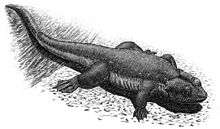Kuwajima Formation
The Kuwajima Formation is an Early Cretaceous geologic formation in Japan. Its precise age is uncertain due to a lack of identifying fossils, but it is probably Valanginian to Hauterivian in age.[1] Dinosaur remains are among the fossils that have been recovered from the formation,[2] including Albalophosaurus yamaguchiorum.[3]
| Kuwajima Formation Stratigraphic range: ?Valanginian-Hauterivian | |
|---|---|
| Unit of | Tetori Group |
| Sub-units | Lower Member, Upper Member |
| Underlies | Akaiwa Formation |
| Overlies | Gomijima Formation |
| Lithology | |
| Primary | Sandstone, Mudstone |
| Location | |
| Country | |
The multituberculate mammals Hakusanobaatar matsuoi and Tedoribaatar reini are known from the Kuwajima Formation.[4] A member of Tritylodontidae, Montirictus kuwajimaensis, has also been recovered from the unit.[5]
Vertebrate Paleobiota
Amphibians
| Amphibians reported from the Kuwajima Formation | ||||||
|---|---|---|---|---|---|---|
| Genus | Species | Location | Stratigraphic position | Material | Notes | Images |
| Shirerpeton[6] | S. isajii | Kaseki-kabe | Facies III | Partial disarticulated skull | Albanerpetontid | |
| Anura | Indeterminate | |||||
Choristoderes
| Choristoderes reported from the Kuwajima Formation | ||||||
|---|---|---|---|---|---|---|
| Genus | Species | Location | Stratigraphic position | Material | Notes | Images |
| Monjurosuchus | Indeterminate | Kaseki-kabe | Facies III |
| ||
| Choristodera | Indeterminate | Kaseki-kabe | Facies III | |||
Squamates
| Squamates reported from the Kuwajima Formation | ||||||
|---|---|---|---|---|---|---|
| Genus | Species | Location | Stratigraphic position | Material | Notes | Images |
| Asagaolacerta | A. tricuspidens | Kaseki-kabe | Facies III | "An association of skull, jaws and postcranial bones of a small lizard with facetted tricuspid teeth, possibly a right maxilla" |
| |
| Hakuseps | H. imberis | Kaseki-kabe | Facies III | An almost complete left dentary | ||
| Kaganaias | K. hakusanensis | Kaseki-kabe | Facies III | "Part and counterpart of articulated partial skeleton comprising parts of the dors. vert. series and parts of the tail, pelvis, and hind limbs" | ||
| Kuroyuriella | K. mikikoi | Kaseki-kabe | Facies III | "A disarticulated skull on four originally conjoined blocks, an association on two small blocks" | ||
| Kuwajimalla[7] | K. kagaensis | Kaseki-kabe | Facies III | |||
| Sakurasaurus | Indeterminate | Kaseki-kabe | Facies III | "Small block with disarticulated association of skull bones, vertebrae, ribs, pelvis and hindlimb bones" | ||
| Paramacellodidae | Indeterminate | Kaseki-kabe | Facies III | |||
| Squamata | Indeterminate | Kaseki-kabe | Facies III | Five distinct taxa | ||
Dinosaurs
| Dinosaurs reported from the Kuwajima Formation | ||||||
|---|---|---|---|---|---|---|
| Genus | Species | Location | Stratigraphic position | Material | Notes | Images |
| Albalophosaurus[3] | A. yamaguchiorum | Kaseki-kabe | Facies III | Partial skull and lower jaws | ||
| Dromaeosauridae | Indeterminate | Kaseki-kabe | Facies III | |||
| Enantiornithes | Indeterminate | Kaseki-kabe | Facies III | |||
| Ornithischia[8] | Indeterminate | Right dentary, left maxilla, isolated teeth | Distinct from Albalophosaurus | |||
| Sauropoda | Indeterminate | Kaseki-kabe | Facies III | |||
| Styracosterna[8] | Indeterminate | Maxillary and dental teeth | ||||
Mammaliaformes
| Mammaliaformes reported from the Kuwajima Formation | ||||||
|---|---|---|---|---|---|---|
| Genus | Species | Location | Stratigraphic position | Material | Notes | Images |
| Hakusanobaatar[4] | H. matsuoi | Kaseki-kabe | Facies III | Dentary fragments and teeth | Eobaatarid | |
| Hakusanodon[9] | H. archaeus | Kaseki-kabe | Facies III | |||
| Montirictus[5] | M. kuwajimaensis | Kaseki-kabe | Facies III | Tritylodontid | ||
| Tedoribaatar[4] | T. reini | Kaseki-kabe | Facies III | "Fragment of right lower jaw with p4" | Eobaatarid | |
| Multituberculata | Indeterminate | Kaseki-kabe | Facies III | |||
See also
- List of dinosaur-bearing rock formations
References
- Fujita, M. (2003). "Geological age and correlation of the vertebrate-bearing horizons in the Tetori Group". Memoir of the Fukui Prefectural Dinosaur Museum. 2: 3–14.
- Weishampel, David B.; Dodson, Peter; and Osmólska, Halszka (eds.): The Dinosauria, 2nd, Berkeley: University of California Press. 861 pp. ISBN 0-520-24209-2.
- Ohashi, T.; Barrett, P. M. (2009). "A new ornithischian dinosaur from the Lower Cretaceous Kuwajima Formation of Japan". Journal of Vertebrate Paleontology. 29 (3): 748–757. doi:10.1671/039.029.0306.
- Kusuhashi, Nao (September 2008). "Early Cretaceous Multituberculate Mammals from the Kuwajima Formation (Tetori Group), Central Japan". Acta Palaeontologica Polonica. 53 (3): 379–390. doi:10.4202/app.2008.0302. ISSN 0567-7920.
- Hiroshige Matsuoka, Nao Kusuhashi and Ian J. Corfe (2016). "A new Early Cretaceous tritylodontid (Synapsida, Cynodontia, Mammaliamorpha) from the Kuwajima Formation (Tetori Group) of central Japan". Journal of Vertebrate Paleontology. Online edition:
- Matsumoto, Ryoko; Evans, Susan E. (2018-01-03). "The first record of albanerpetontid amphibians (Amphibia: Albanerpetontidae) from East Asia". PLOS ONE. 13 (1): e0189767. doi:10.1371/journal.pone.0189767. ISSN 1932-6203. PMC 5752013. PMID 29298317.
- Evans, Susan E.; Manabe, Makoto (March 2008). "An early herbivorous lizard from the Lower Cretaceous of Japan". Palaeontology. 51 (2): 487–498. doi:10.1111/j.1475-4983.2008.00759.x. ISSN 0031-0239.
- Barrett, Paul M.; Ohashi, Tomoyuki (October 2015). "Ornithischian dinosaur material from the Kuwajima Formation (Tetori Group: Lower Cretaceous) of Ishikawa Prefecture, Japan". Historical Biology. 28 (1–2): 280–288. doi:10.1080/08912963.2015.1032273. ISSN 0891-2963.
- Rougier, Guillermo W.; Isaji, Shinji; Manabe, Makoto (2007). "AN EARLY CRETACEOUS MAMMAL FROM THE KUWAJIMA FORMATION (TETORI GROUP), JAPAN, AND A REASSESSMENT OF TRICONODONT PHYLOGENY". Annals of Carnegie Museum. 76 (2): 73. doi:10.2992/0097-4463(2007)76[73:aecmft]2.0.co;2. ISSN 0097-4463.
This article is issued from Wikipedia. The text is licensed under Creative Commons - Attribution - Sharealike. Additional terms may apply for the media files.

